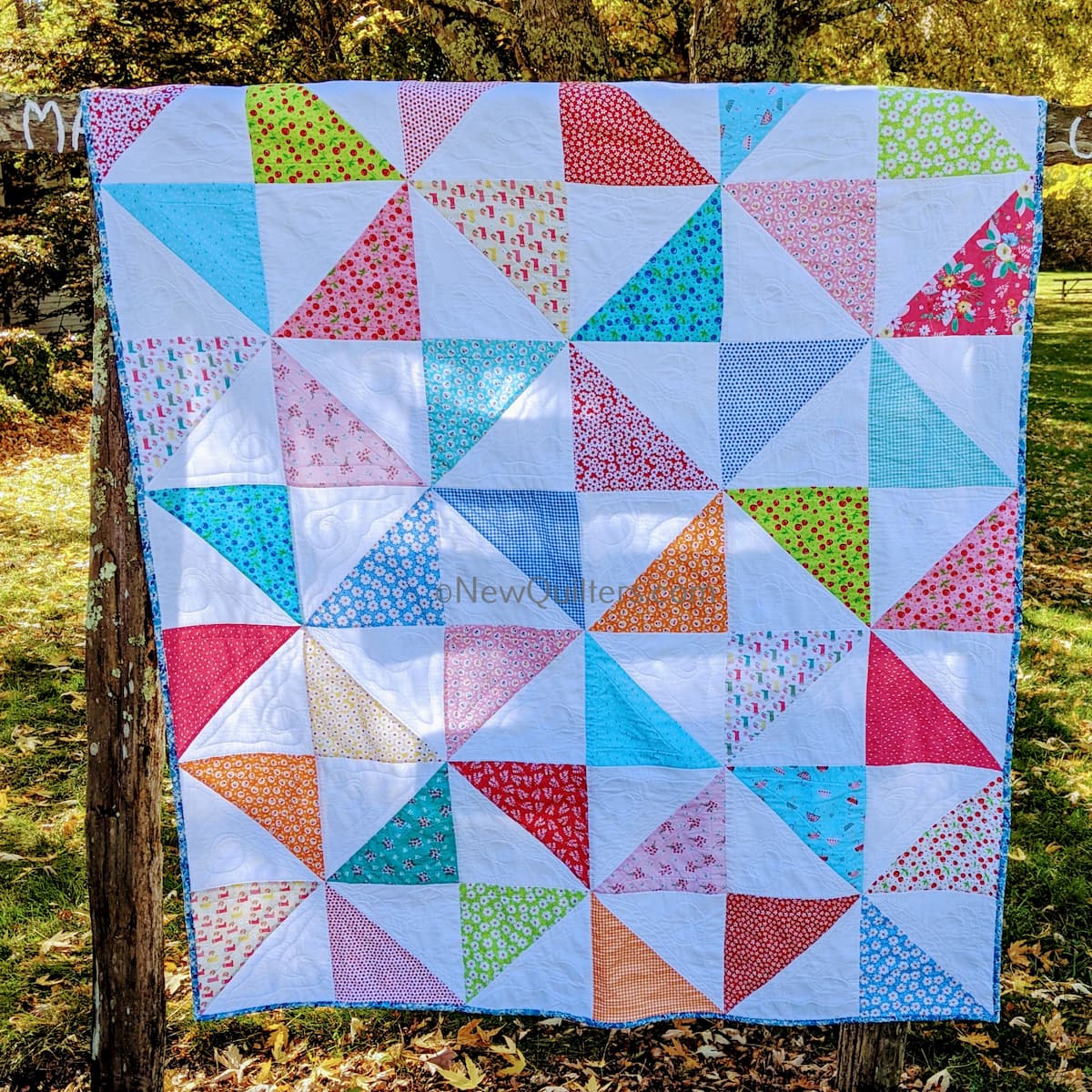Pinwheel Layer Cake Lap Quilt

I liked making a pinwheel baby quilt so well that I just finished quilting a larger lap-sized version of the same pinwheel pattern.
If you know how to make a half-square triangle block, you can make this quick and easy quilt. Start with 10″ squares from a fabric layer cake collection (or you can cut some of your favorite fabrics into 10″ squares), combine them with white 10″ squares to make half-square triangle blocks, and use the pattern below as a guide to arrange them into a quilt.
The finished quilt is the perfect size for snuggling up in on the couch or in your car. Thanks to my friend Ruthmary for piecing the quilt.

If you don’t know how to make half-square triangles, they’re easy! Click or tap here to see our tutorial.
Pinwheels Layer Cake Lap Quilt Pattern
Size: 54″ x 72″ (137 x 183 cm)

Fabric You Will Need
- Twenty-four 10″ squares of white cotton quilt fabric, or 1-2/3 yards if you want to cut your own squares from yardage.
- Twenty-four 10″ squares of colored fabrics that look good together. I combined fabrics from two different layer cake collections: Singing in the Rain by Beverly McCullough (Riley Blake), and Badda Bing, by Me & My Sister (Moda.) I find that using more than one collection gives the quilt a nice variety.


- Binding: 1/2 yard, cut into seven 2-1/2″ width-of-fabric strips.
- Backing fabric: 3-1/4 yards (this allows for an extra 2″ of backing fabric all around the quilt.)
- Batting: Double/full batting package, or one piece 56″ x 74″.
Step by Step Instructions
- Blocks: Combine each white square with a colored square and make each set of two squares into half-square triangle blocks. The 24 sets of squares will make 48 triangle blocks. Learn how to make half-square triangle blocks.

- Use a ruler and rotary cutter to trim the blocks to 9-1/2″.
- Using the pattern above as a guide, lay out the blocks into four rows of four blocks each.
- Sew the rows together, using scant 1/4″ seams.
- Batting and backing: Cut the batting and backing fabric to 56″ x 74″. If you use regular-width quilt fabric, you will need to piece the backing to make it the right size. If you use extra-wide backing fabric, you can simply cut it to size.
- Layer and baste the quilt top, batting, and backing. Learn about basting.
- Quilt the layers together. I recommend stitching in the ditch as the first step in machine-quilting. If you also want to add free-motion quilting, there are a number of different styles to try. I stitched a free-motion triangle inside each colored triangle, and a kind of free-form cloud motif in the white triangles. Here’s how it looks on the back of the quilt:

- Binding: Cut seven strips that measure 2-1/2″ x the full width of your fabric, from selvage to selvage.
Make the strips into quilt binding, then sew the binding to the quilt. Learn how to bind a quilt with no hand sewing.
I used polyester fleece as backing for this quilt instead of the traditional batting/backing fabric combination. In the cool-all-year Northern California climate, fleece makes sense. If you live in a warm or hot climate, you may want to omit the batting layer and use a single layer of flannel for the quilt backing. Flannel is just as soft as fleece and much thinner and lighter.
Learn how to back a quilt with fleece.
If you decide to use a fleece backing, keep in mind that the patterns and colors and patterns from the fleece will show through white areas on the quilt top. I didn’t want that look for this quilt and as a result used a solid white fleece backing. Another option that will prevent show-through from the back of the quilt is to use the traditional combination of batting and backing fabric. The batting will keep anything from showing through on the quilt top.




Thank you for this lovely quilt pattern as I do have a supply of Layer Cakes.
You’re most welcome, Dottie!
Christine